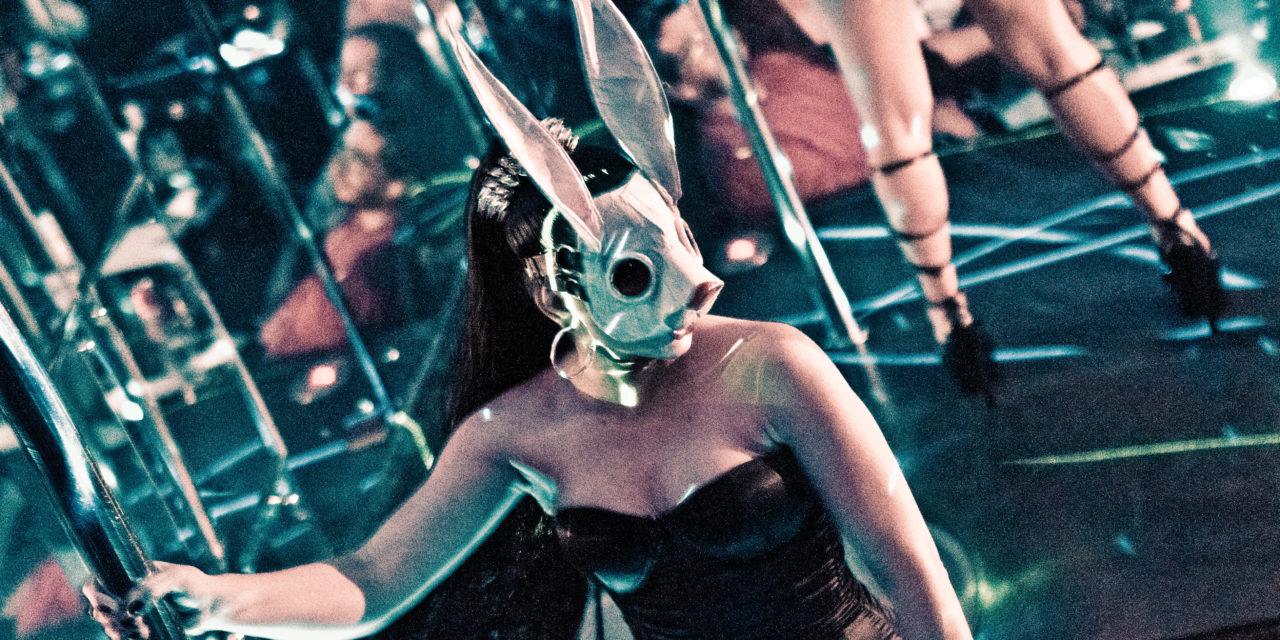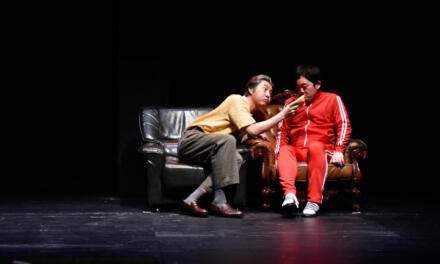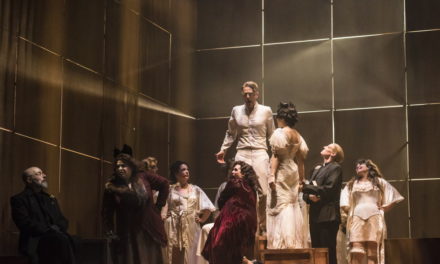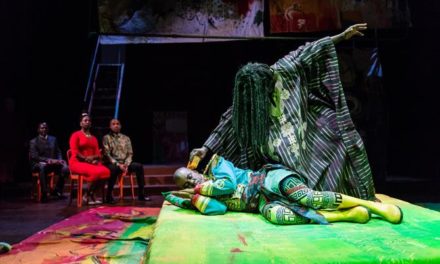Uruguayan playwright Sérgio Blanco is well known in Latin America and other countries. He is one of the directors of the COMPLOT (Contemporary Performing Arts Company) and has already received some of his country’s most important prizes, such as the Uruguayan National Drama Award, the City of Montevideo, the National Theater Fund and the Florencio Sanchez Award for Best Playwright. In Cuba, he received the Casa de las Americas prize. In 2017 Blanco was nominated in London as the best author of the West End Award Off for the creation of Thebes Land. Kassandra, written in 2008, has been recently staged in Florianopolis, a city in the south of Brazil.
The most beautiful daughter of Priam and Hecuba was courted by Apollo who presented her with the gift of premonition. But she didn’t fall in love with Apollo, so he promptly deprived her of the capacity of persuasion, so she would continue to have visions, but nobody would take her seriously. This is the psychological profile we know from the Homeric poems, as well as through Aeschylus and Euripides’ dramaturgy. She was the one who has warned her compatriots not to open the gates of Troy to the suspicious horse, sure that it was bringing destruction within. She was condemned never to make herself understood, never to surpass the privileged condition of her premonitions to turn them into experiences shared with her fellows.
From these shadows, Kassandra reappeared in Florianópolis. Wrapped in a leopard coat, long lacquer black boots, selling cigarettes at the door of a suspicious nightclub, which name, Bokarra, suggests a compelling libidinal additive. Milena Moraes resurrected the creature from her mythical sleep and made her assert herself among humans to once again speak about her premonitions. Inside the room, decorated with mirrors from bottom to top reflecting the black, red and gold adornment, Kassandra removes her coat and reveals a sculptural body worked in BDSM style, capable of burning the imagination of the most introverted spectator. She speaks English. Through this foreign language that is not hers (and not ours either), the Uruguayan playwright Sérgio Blanco idealized his Kassandra as a migrant: she came from an unknown country to another that nobody knows precisely where it is. With crude and poor English words, in a language certainly learned from the movies she sees in the afternoon or from the cartoons at dawn on cable TV, she tries to explain the true story of her life.

Milena Moraes. Photo Credit: Cristiano Prim.
Stolen myth
The myth is always a language’s theft, and here we have by the sortilege of this cisplatin playwright, another kidnap perpetrated against the Greek pantheon. Updated, embedded in the global capitalism voracious economy, Kassandra’s mission is to warn everyone that a lie has prevailed for millennia, but now it is time to reveal the whole truth, the horrible truth of her past. She was born a boy, but her brother Hector turned him into a female, so she decided to assume that condition once and for all: she is a transvestite. She has never been mad or hysterical, as the poets say, and she is not a lesser figure in the tragic plots, nor a prophetess or the pithy of a cult. She has always told the truth in spite of the fact that the truth often sounds like a nightmare or a horror legend. And if she is there, at that moment, is to enlighten everyone about the war in her country.
This brief context allows us to understand the theft mentioned above. This Kassandra is not that Kassandra, but another myth forged in her image and similarity, though all the signs are inverted in relation to what we know about them. We realize that the myth in which we have always believed has been previously stolen, as it is proper of this fictitious matter whose mass words we have swallowed, by the poetic effects, without realizing its contradictions. Myths entertain themselves, rob each other and regurgitate new myths, so they can be able to walk with their own legs.
Instead of feeling repulse for Agamemnon, this Kassandra willingly surrenders to the king of Argos, especially after realizing that he truly takes pleasure in anal intercourse. As for the other male characters in the plot, she has no problem in confessing that has given all them up and that now she can comment in massive detail about the sexual performance of each one of them. As for Clytemnestra, she tells us all the details about her death at the hands of the infuriated queen. If in ancient Greek theatre death never enters the scene, the blood was only referred to and the audience was kept away from the violence, in this play that censorship is denounced: the sordid queen will pluck her testicles and give them to the palace dogs. The true tragedy of Kassandra finds its climax here.
But she declares herself optimistic and firmly believes that one day she will be able to return home, just as Scarlet O’Hara once returned to her beloved Tara. Her idol is a Bugs Bunny hanging from a huge key holder that she shows to the audience. In Sergio Blanco’s text, the final scene revolves around cards reading, when the protagonist foresees a disaster with a taxi in which she embarks. In the performance directed by Renato Turnes, this ending was altered with excellent results. Wearing a rabbit mask, she reads in Greek a few excerpts from the pages of Euripides, in a metatheatrical exercise that achieves a great effect. Then, surrounded by a heady technopop score, she performs a pole dance while the lights sparkle. A new myth has just been born.
Kassandra is one of those obscure desire objects that we rarely have the pleasure of tasting. It destabilizes, one by one, the established reasonings and accumulated certainties, making the top turn in reverse with its astute poetic game and, at the same time, enormous simplicity. That’s because as a poetic fact, myth lends itself to ramblings, to associations, to interchanges, making their meanings open and allowing their network to gather with beings, objects and things of a very different nature from one another.
Battles
The play offers a very provocative counterpoint. Kassandra aspires to be some kind of Scarlet O’Hara. She also identifies herself with Bugs Bunny and her cell phone’s tune is an ABBA’s song. These are all consumer products in its most infamous condition. Besides, she recites with contrite and pathetic feelings the original Euripides verses, in a language we cannot grasp, although its potent sonority still reaches us today, in its strange and powerful resonance. The ruined and simplistic English spoken during the entire show is assimilated, after the initial impact, as a language like any other, capable of enchantment and pleasure, aversion and discovery, a product of strangeness as powerful as it comes closest to its fragile condition, almost childlike, of a human being at the edge of her existence. Thus, the show is a miscellany of beings, objects, and things, unified by the poetic network of sounds, gestures, lights, perfect costumes and, above all, the robust performance of the actress.
Brazilian actress Milena Moraes, the core of the project, has gone to the last consequences to make it fully complete. For the first thing, the choice of place, a bold initiative that shifts values and feelings among the public. Then, the general design of production, that remarks a few aspects of bondage culture, the erotic fetishism of leather and ropes, and the transgressions of this universe.
For the last three years, Florianopolis has had a Cultural Marathon, an intensive program that takes theatres, squares, and streets to give visibility to its local artists. Organized by the city hall, it is financed with funds from the state. Kassandra was invited for the last edition and appeared in the event folder, posters, and other media until a few days before the program began. Then, like a bomb, the news circulated that the play would not be presented, but nobody knew exactly why.
In the administrative process that circulated table to table in public agencies, the Legal Adviser of the Government stated that the venue of the show was not public, which made it impossible to pass on Government money and thus the show had to be suspended. The following day, the organizers of the Cultural Marathon tried a change of venue, in a way to make the presentation viable. It was in vain. The artists refused this arrangement, justifying that the show had been created there and could only exist there. Either it would be presented at the nightclub, or it was out of the programming.

Kassandra at Sayonara Night Club, in Belo Horizonte, Brazil. Photo Credit: Alexandre Guzanshe.
On censorship
In the eve of the event, the organizers officially announced, in short, that the play was banned. In protest, several other shows and concerts refused to join the Marathon, and the event was a fiasco. For the other shows, members of the audience appeared wearing rabbit masks, an allusion to the character, since Bugs Bunny is one of its symbols.
Such sequence of episodes seems to reinforce the power of myth. As a way of explaining one aspect of the so-called “wild thinking,” Levi-Strauss refers to the game with the dead, carried out in different cultures when they need to send the souls of the deceased to their place of origin, liberating the living ones to share the same space.
The artists who created Kassandra operated as bricoleurs, guided by their intuitions and not by a calculated plan to confront the morality of the city. By choosing the Bokarra nightclub as a cultural venue, they let their integrative energies of social cohesion flow, incorporating that supposedly damned place into the city’s high culture circle. And they succeeded since the broad public that followed its season is the most precise index of the adhesion achieved. That is, through an artistic event, the stigma that existed before was at least partially appeased. One of the peculiarities of bricolage is to navigate between different social rules and previous separations, breaking limits and overcoming interdicts, being this transgressive character its strongest brand. In the symbolic order that governs its internal organization as an artwork, Kassandra disregards the boundaries between theatre and performance art, between show and ritual, in a profane adventure towards the unknown.
As a performance that has been staged on the threshold, moving from here to there, engaging a high conception of theatre, whether because of the undefined language it employs, whether because of the transgender condition of the character, or the space she inhabits. This permanent movement between different instances is one of its most potent pillars. Burlesque, hilarious, dramatic and tragic moments are side by side in this art piece, the expressive alibis that allow Milena Moraes to exhibit it in full form and unified purposes: to evoke an archetype, a lost myth, its unstable human condition and hidden inner fragility, yet in a luscious package. Today Kassandra is resurrected in the skin of this creature who, despite everything, resist the totalitarian order. The performance displays a parresia, although not through the character’s fable, but through the performance itself. In her body, Milena Moraes unites things that are disparate, difficult to join, reaching a contagious state of fullness, in the best Dionysian trance.
The white censorship suffered by the performance in the Cultural Marathon reveals how much the symbolic order of the city has been shaken. Later, everybody acknowledged that the prohibition order came directly from the Governor, who was discontented to see the logo of the nightclub printed on an official poster of his government, that is, the legitimation of the place within the polis. Thus, in the game of confrontation between the dead and the living contemporaries, a third party wins: the nightclub in the heart of the city, which stands against its conservative taboos.
From the following year, the Cultural Marathon was suspended, but Kassandra continued her career throughout the country, at the door of countless other willing nightclubs interested in listening to her story. This story is similar to that of thousands of migrants who are crossing seas and deserts, fleeing from hunger, wars, and destruction. The atavistic force of the myth seems to resist all weather.
This post was written by the author in their personal capacity.The opinions expressed in this article are the author’s own and do not reflect the view of The Theatre Times, their staff or collaborators.
This post was written by Edélcio Mostaço.
The views expressed here belong to the author and do not necessarily reflect our views and opinions.


















